Related Research Articles

Napoleon's Last Battles is a board wargame published by Simulations Publications in 1976 that simulates the last four battles fought by Napoleon. It was one of SPI's most popular games, and also received many positive reviews.
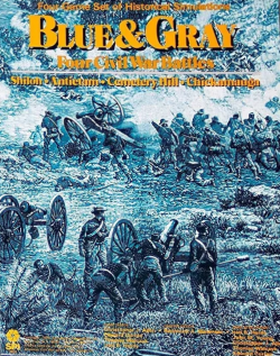
Blue & Gray: Four American Civil War Battles is a board wargame originally published by Simulations Publications, Inc. (SPI) in 1975 that simulates four battles from the American Civil War.

The Art of Siege, subtitled "Four Great Siege Battles", is a collection of four board wargames published by Simulations Publications Inc. (SPI) in 1979 that simulates four famous sieges.

Frederick the Great, subtitled "The Campaigns of The Soldier King 1756–1759", is a board wargame published by Simulations Publications Inc. (SPI) in 1975 that simulates several of the campaigns of Frederick the Great in Central Europe during the Seven Years' War. When SPI ran into financial difficulties, they sold the rights to the game to Avalon Hill, who produced a second edition in 1982.

Marengo: Napoleon in Italy, 14 June 1800 is a board wargame published by Simulations Publications Inc. (SPI) in 1975 as one of four games packaged together in the Napoleon at War "quadrigame". Marengo was also released as a separate game the same year. The game simulates the Battle of Marengo between Austrian and French forces.

Napoleon at War, subtitled "Four Battles", is a collection of four board wargames published by Simulations Publications Inc. (SPI) in 1975 that simulates various battles fought by Napoleon.

Bloody Ridge, subtitled "Turning Point on Guadalcanal, September 1942", is a board wargame published by Simulations Publications Inc. (SPI) in 1975 that simulates the Guadalcanal Campaign during World War II. The game was originally published as part of the Island War: Four Pacific Battles "quadrigame" — a gamebox containing four games simulating four separate battles that all use the same rules. Bloody Ridge was also published as an individual "folio game."
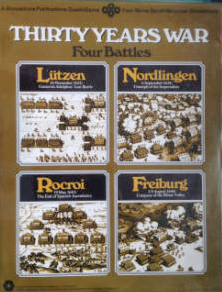
Thirty Years War, subtitled "Four Battles", is a "quadrigame" — four separate board wargames packaged in one box that use a common set of rules — published by Simulations Publications Inc. (SPI) in 1976. The four games simulate different battles during the Thirty Years' War, and were sold individually as well as in the quadrigame format. Some of the games were well received by critics, but overall, the quadrigame did not sell well.
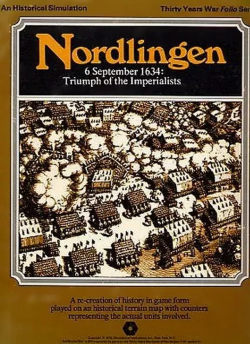
Nordlingen, subtitled "6 September 1634 – Triumph of the Imperialists", is a board wargame published by Simulations Publications Inc. (SPI) in 1976 that simulates the 1634 Battle of Nordlingen during the Thirty Years' War. Nordlingen was originally sold as one of four separate games packaged together in Thirty Years War, a "quadrigame". Many critics called it the best game of the four, and Nordlingen was also published as a separate game.

Freiburg, subtitled "3–9 August 1644 – Conquest of the Rhine Valley", is a board wargame published by Simulations Publications Inc. (SPI) in 1976 that simulates the 1644 Battle of Freiburg during the Thirty Years' War. Freiburg was originally sold as one of four separate games packaged together in Thirty Years War, a "quadrigame", but it was also published as an individual game. It received poor reviews from critics, who called it the weakest of the four games in the Thirty Years War box, "a series of slogging matches", "not much fun", and "relatively boring."

Breitenfeld, subtitled "Triumph of the Swedish System", is a board wargame published by Simulations Publications Inc. (SPI) in 1976 that simulates the 1631 Battle of Breitenfeld during the Thirty Years' War. Breitenfeld was a free game that appeared in Strategy & Tactics, designed to promote SPI's soon-to-be-launched wargame Thirty Years War. Breitenfeld proved popular and was also published as part of SPI's "folio" series of games.

Arnhem, subtitled "Operation Market-Garden, September 1944" and also published as A Bridge Too Far: Arnhem, is a board wargame published by Simulations Publications Inc. (SPI) in 1976 that simulates Operation Market Garden during World War II, when Allied forces attempted to create a salient in the Netherlands, using paratroopers to take strategic bridges over the Rhine. Arnhem was originally published in the WestWall "quadrigame", but was also packaged for sale as an individual game.

Blue & Gray II, subtitled "Four American Civil War Battles", is a collection of four board wargames originally published by Simulations Publications, Inc. (SPI) in 1975 that each simulate a battle from the American Civil War. It is the sequel to Blue & Gray published earlier in the year. Each of the four games was also published as individual "folio games."

Hurtgen Forest, subtitled "Approach to the Roer, November 1944 ", is a board wargame published by Simulations Publications Inc. (SPI) in 1976 that simulates the Battle of Hürtgen Forest during the final year of World War II. The game was originally published by SPI as part of a four-game collection titled Westwall: Four Battles to Germany, but it was also released as an individual "folio game." While the quadrigame Westwall received good reviews from critics, the static nature of Hurtgen Forest was less well received.
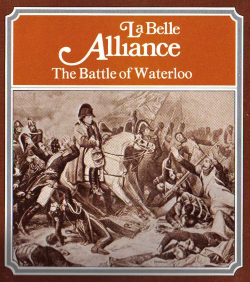
La Belle Alliance: The Battle of Waterloo is a board wargame published by Simulations Publications Inc. (SPI) in 1976 that simulates the Battle of Waterloo in 1815. It was one of four games that were published as part of the "quadrigame" titled Napoleon's Last Battles, but was also released as an individual "folio game", packaged in a shrinkwrapped cardboard folio.
Acre: Richard Lionheart's Siege is a board wargame published by Simulations Publications, Inc. (SPI) in 1978 that simulates the Siege of Acre in 1191. The game was originally part of the four-game collection The Art of Siege, and was also released as a stand-alone "folio" game.
Tyre: Alexander's Siege and Assault is a board wargame published by Simulations Publications, Inc. (SPI) in 1978 that simulates the Siege of Tyre in 332 BCE. The game was originally part of the four-game collection The Art of Siege, and was also released as a stand-alone "folio" game.
Sevastapol: The First Modern Siege is a board wargame published by Simulations Publications, Inc. (SPI) in 1978 that simulates the Siege of Sevastopol during the Crimean War. The game was originally part of the four-game collection The Art of Siege, and was also released as a stand-alone "folio" game.

Ligny: Incomplete Victory is a board wargame published by Simulations Publications Inc. (SPI) in 1976 that simulates the Battle of Ligny. Ligny was originally published as one of four games in the popular collection Napoleon's Last Battles, but was also released as an individual game.
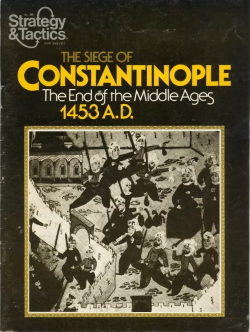
The Siege of Constantinople, subtitled "The End of the Middles Ages 1453 A.D.", is a board wargame published by Simulations Publications Inc. (SPI) in 1978 that simulates the land combat during the Fall of Constantinople in 1453 CE. It was published as a promotional precursor to SPI's four-game collection The Art of Siege, but was received so poorly that one critic speculated it may have actually convinced players not to buy The Art of Siege.
References
- 1 2 Olivier, Luc (April 2004). "The Art of Siege". Simulacrum. No. 20. pp. 11–15.
- ↑ Lynn, John A. (1999). The Wars of Louis XIV, 1667–1714. Longman.
- 1 2 Freeman, Jon (1980). The Complete Book of Wargames. New York: Simon & Schuster. p. 113.
- ↑ Jarvinen, J. Richard (April 1980). "A First Impression: Lille, The Classic Vauban Siege". Fire & Movement . No. 21.
- ↑ Hatton, Peter (December 1981). "The Passing of the Pike". The Wargamer . Vol. 1, no. 17.